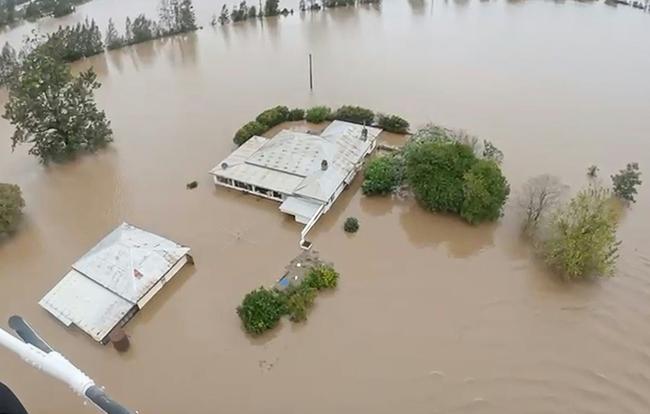Record floods devastate eastern Australia
Record floods devastate eastern Australia

Breaking News
Don't miss out on the headlines from Breaking News. Followed categories will be added to My News.
Record floods cut a destructive path through eastern Australia on Friday, caking houses in silt, washing out roads and separating 50,000 people from help.
Four bodies have been pulled from vast tides of floodwater engulfing parts of northern New South Wales, a fertile region of rivers and valleys some 400 kilometres (250 miles) up the coast from Sydney.
Salvage crews launched a major clean-up operation as waters receded Friday, surveying the damage from half a year's worth of rain dumped in just three days.
"Emotions were high as we were rescuing a lot of people who are distraught when we get to them," rescue worker Jason Harvey told AFP on Friday, describing "frantic" efforts over recent days.
Kinne Ring, mayor of the flood-stricken farming town of Kempsey, said dozens of businesses had been swamped.
"Houses have been inundated," she told national broadcaster ABC.
"There's water coming through the bottom of houses, it's really awful to see and the water is going to take a bit of time to recede."
State Emergency Service boss Dallas Burnes said more than 2,000 workers had been deployed on rescue and recovery missions.
"A real focus for us at the moment will be resupplying the isolated communities," he said, adding that 50,000 people were still stranded.
Burnes said rescue crews had plucked more than 600 people to safety since waters started rising earlier this week.
People clambered atop cars, houses and highway bridges before helicopters winched them away.
Although the floods were easing, Burnes said the stagnant lakes of muddy water still posed a threat -- including from snakes that may have slithered into homes in search of shelter.
"Floodwaters have contaminants. There can be vermin, snakes. You need to assess those risks.
"Electricity can also pose a danger as well."
-'Horrific circumstances' -
The storms have dumped more than six months' worth of rain over three days, the government weather bureau has said, smashing flood-height records in some areas.
"These are horrific circumstances," Prime Minister Anthony Albanese said Friday as he travelled into the disaster zone.
"The Australian Defence Force will be made available. There's going to be a big recovery effort required," he told local radio.
"There's been massive damage to infrastructure and we're going to have to all really pitch in."
In Taree, local business owner Jeremy Thornton said the "gut-wrenching" flood was among the worst he had seen.
"It is pretty tough, we've had a few moments but you have to suck it up and push on," he told AFP on Thursday.
"We are reliving it every second -- hearing the rain, hearing the helicopters, hearing the siren."
Locals spotted dead cows washing up on beaches after swollen rivers swept them from their pastures inland.
Although a string of flood warnings have been downgraded, some towns were still cut off on Friday afternoon, making it difficult to assess the damage.
The government has declared a natural disaster, unlocking greater resources for affected areas.
- 'Compelling evidence' -
From the arid outback to the tropical coast, swaths of Australia have recently been pummelled by wild weather.
The oceans surrounding Australia have been "abnormally warm" in recent months, according to Australia's government weather bureau.
Warmer seas evaporate more moisture into the atmosphere, which can eventually lead to more intense rains.
Although difficult to link to specific disasters, climate change is already fuelling more extreme weather patterns, scientists warn.
Flood modelling expert Mahdi Sedighkia said this week's emergency offered "compelling evidence" of how climate change could affect regional weather patterns.
sft/lec/tym
Originally published as Record floods devastate eastern Australia


